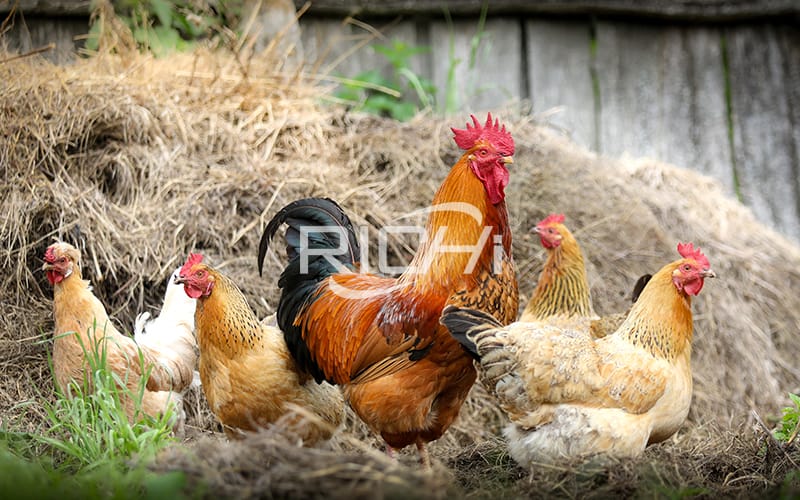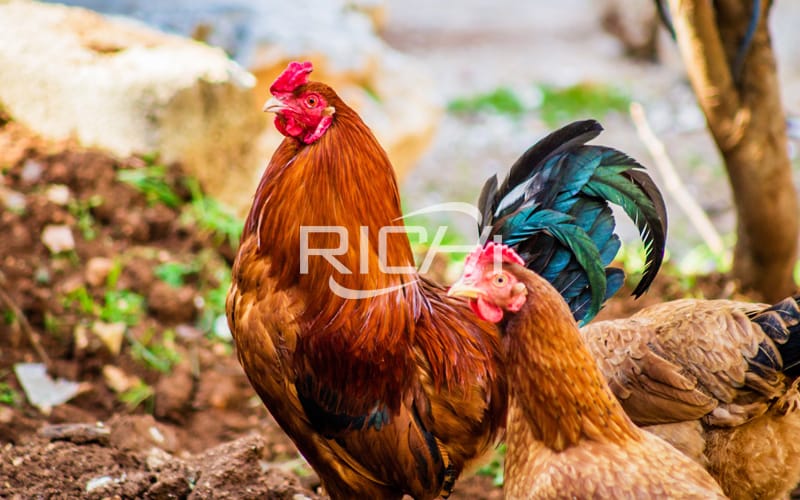Chicken feed formulas at different stages of free-range chickens
Free-range native chickens can use and expand the activity space of the chickens, so that the chickens can get sufficient movement. Therefore, the free-range chickens are very lively. The cut feathers are brighter than the captive chickens, and the meat taste is more tender than the captive chickens. However, judging from the current breeding situation of free-range chickens, there is also a certain degree of blindness. For this reason, many years of demonstration and research have been conducted on how to meet the nutritional needs of free-range chickens at different growth stages, and to more rationally choose suitable local ecological chicken breeding models.

1. The phased management method of "nutrition + flavor" for free-range chickens
"Nutrition" refers to feeding the chicks with reasonable full-price compound feed during the brooding stage, focusing on meeting the nutritional needs of the chicks. Chicks have the characteristics of strong metabolism, fast growth, strong sensitivity, sparse villi, poor body temperature regulation, weak digestion, and low disease resistance. These characteristics determine the nutritional level of chicks, feeding management, sanitation and disinfection and epidemic prevention are very important. Paying attention to the nutrition of the chicks and strengthening the feeding management at this stage is the key to ensuring the brooding effect.
"Flavour" means that during the stocking stage, the focus is on improving the flavor of chicken, making full use of the farmers' existing forage resources, and appropriately preparing some low-cost concentrate supplements, mainly relying on chickens being free in natural environments such as hillsides and grasslands. Feed on various insects, plants and seeds, and increase nutrition such as animal and plant protein and trace elements. At this stage, the main methods are to reduce feed costs, strengthen exercise, reduce fat deposition, and appropriately control growth speed, focusing on cultivating the unique taste and flavor of native chickens, adapting to the consumer market, and improving chicken breeding benefits.
2. Feed preparation and feeding management at the brooding stage
(1) Example of preparation of complete feed for chicks
In many years of production practice, we have summed up the complete feed for chickens at different stages that is suitable for farmers in this area. The feeding effect can fully meet the variety needs, the raw materials are sufficient, the price is reasonable, and the survival rate of the brooding period can reach more than 95%. It has become one of the best brooding materials chosen by local and surrounding farmers.
①Formula 1. (Feed for chicks of 0-2 weeks old) 56.0% corn, 6.0% bran, 4.65% broad beans, 20.0% soybean meal, 3.0% rapeseed cake, 3.0% flax cake, 3.0% fish meal, 0.35% salt, 4.0% premix %.
②Formula 2. (Feed for 3-4 weeks old chicks) 59.0% corn, 5.0% bran, 4.65% broad bean, 19.0% soybean meal, 3.0% rapeseed cake, 2.0% flax cake, 3.0% fish meal, 0.35% food, 4.0 premix %.
③Formula 3. (5-7 weeks old chick feed) 62.0% corn, 6.0% bran, 3.65% broad bean, 15.0% soybean meal, 4.0% rapeseed cake, 3.0% flax cake, 2.0% fish meal, 0.35% salt, 4.0% premix %.
(2) Key measures for chicken feeding and management
A reasonable full price compound feed is the material basis and the primary condition for brooding. However, according to the physiological characteristics of the chicks, feeding management, sanitation and disinfection and epidemic prevention during the brooding period are also very important. Grasping the "two openings" and doing a good job of "three controls" and "three degrees" is the key to the success of brooding.
① The boiled water and the feeding of the chicks should be based on the principle of boiling water first and feeding later. After the chicks come out of the shell, there is still a part of the egg yolk that has not been absorbed. Drinking water can accelerate the metabolism of this nutrient. Feeding chicks should be done: the starter feed should be a full-price compound feed with rich nutrition, easy digestion, and strong palatability. The trough should be sufficient, and the number of feedings will gradually decrease according to the increase in age. Due to poor digestive function, chicks cannot overeating. If overeating, it will cause indigestion and cause digestive tract diseases. It can be fed 80% full.
②Control the ventilation, light and disease occurrence of the chicken house.
a. Control ventilation. Under the conditions of high humidity and high density, the brooding house emits a lot of harmful gases such as ammonia and carbon dioxide due to breathing, feces and wet litter, which pollutes the air. The purpose of ventilating the chicken house is to eliminate harmful gases and replace fresh air in the chicken house, and to prevent the relative humidity in the house from gradually increasing. The correct approach is: during the brooding period, open the windows on the sunny side appropriately at around 12 o'clock in the morning to allow air convection, and the window leaves are half open to prevent cold wind from blowing directly on the chicks. The window opening time is generally 0.5 to 1 h. In order to prevent the room temperature from decreasing, the room temperature can be increased by 1 to 2 ℃ before ventilation, and the room temperature will be reduced to the original room temperature after ventilation.
b. Control the light. Light can promote the chicks to eat and drink, increase exercise, promote the development of muscles and bones, prevent diseases, and improve production performance. When the chicks are 3 weeks old, the chicks can be placed outside the house at noon on a sunny day (the climate is relatively warm), soaked in the sun and exercise for 1 to 2 hours, which can promote the growth and development of the chicks and promote the chicks to gradually adapt to the natural environment.
c. Control the occurrence of diseases. The young chicks are small in size and poor in disease resistance. Once a disease occurs, the infection is rapid, the mortality rate is high, and the loss is large. Therefore, we must do a good job in the prevention and deworming of chicks. After the chicks enter the brooding house, they must first use 0.01% potassium permanganate solution as drinking water for the chicks to disinfect the gastrointestinal tract.
After feeding every day, wash the utensils and disinfect them with disinfectants; pay attention to the hygiene of the brooding house and its surrounding environment; The litter should be changed frequently to keep the air fresh in the house; the feed and medicine should be fed strictly according to the standard, and it is strictly forbidden to feed moldy and deteriorating feed to prevent feed poisoning; if there are sick and dead chicks, they should be dissected, diagnosed, prevented and treated in time. Treat the disease as early as possible, prevent the disease first, bury the dead chickens deeply or burn them, and strictly disinfect them to completely eliminate the source of infection.
③ Grasp the temperature, humidity and density.
a. Proper temperature is the key to raising chicks well. Generally, the temperature requirements of chicks are: 34-35 ℃ for 1-3 days old, 32-33 ℃ for 4-7 days old, and 2~3 ℃ every week after 7 days of age until 20 ℃, about 6 Within weeks, the chicks can adapt to the natural environment.
b. Keep proper humidity in the chicken house. The humidity in the brooding house is too high or too low for the growth and development of the chicks. The ideal humidity is: the relative humidity of the first week of age is 70% to 75%, the second week of age drops to 65%, from the third week of age At the beginning, try to keep it at 55-60%.
c. Also pay attention to the density of the chicks. A reasonable stocking density is an important condition to ensure the health and growth of the chickens, because the density is directly related to the air, humidity, hygiene and the occurrence of habit in the brooding house. Generally speaking, it is 30 birds/m2 in the first week, 25 birds/m2 in the second week, 20 birds/m2 in the third week, 15 birds/m2 in the fourth week, and 10 birds/m2 in the fifth week. In addition, the stocking density of chicks must be flexibly controlled according to breeds, seasons, sex, chicken house structure, ventilation conditions and feeding methods.

3. Preparation of concentrate supplements and chicken management methods in the stocking stage
(1) Mixing ratio of concentrate supplements
Generally, the time to start stocking is determined according to the growth of the chicks, climate conditions, etc. Generally, stocking can be carried out at about 5 weeks of age. After the chicks enter the stocking stage, the brooding complete chicken feed can be gradually replaced with self-made concentrate supplements in 1 week. Supplements are prepared by adding chicken premixe feed as appropriate based on the nutrients that can be freely consumed by free-range chickens and the existing raw materials such as crops and forages produced by farmers.
In recent years, in the northern mountainous area and the mountainous chicken-raising demonstration base, the following supplementary ingredients have been used: corn 60.0%, wheat bran 12.0%, alfalfa meal 15.0%, rapeseed cake 3.0%, flax cake 2.0%, peas 3.7%, 0.3% salt, 4.0% premix. The stocking period is 120 days, the slaughter weight is about 2 kg, and the survival rate during the stocking period is over 98%. The average net income of raising chickens is 15-20 yuan per chicken, and the benefits are obvious.
(2) Ecological free-range chicken management method
Use resources such as barren hills, wild slopes, woodlands, pastures, orchards, and implement management methods that combine farming and large-scale farming according to conditions. The first is the farmer's scattered rearing, that is, raising mixed chicks and roosters for about 100 days and selling them as native chickens, leaving the hens to lay eggs for one cycle and then eliminating them. It is suitable for ordinary farmers and does not require specialized breeding staff.,family members can take care of it.
The investment is small, labor-saving, and easy to operate; the second is large-scale breeding, that is, focusing on cultivating more than one hundred large households and ten thousand key villages. The local chicken fry will be free-ranged for 120 to 150 days and sold when the body weight reaches about 2 kg. Two batches a year are raised. It is generally chosen to be implemented in farmers who have the ability to raise chickens, have grassland, hillside and other stocking conditions, and have sufficient labor. Relying on increasing the scale of breeding to improve efficiency, relying on the creation of distinctive brands to occupy the market, with the goal of gradually realizing industrialized production.
If you have the following questions, welcome to consult Richi Machinery:
feed processing machine for poultry farm
farm poultry animal pellet mill machine chicken duck pig feed pelletizer new livestock supplies
machine for grinding maize for chicken feed in kenya
poultry feed mill business plan
chicken pellet feed production line video
easy way to make poultry feed for growing chickens
10 ton per hour poultry feed manufacturing process flow chart
things to plant for chicken feed
chicken manure for fish feed mill
low cost poultry feed formulation
machines needed for poultry feed production
animal poultry feed plant production line 5 ton
chicken feed machine accessories
1-3TPH poultry farming equipment poultry feeds
chicken feed production machine in saudi arabia
broiler poultry feed equipment 5-10TPH poultry feed
If you want to built one complete pellet production line in your country, pls send the inquiry to us. We will customized design according to your requirement.



